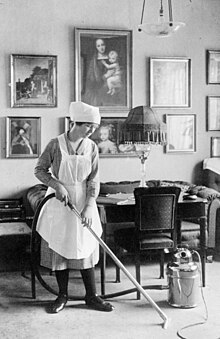


A maid, housemaid, or maidservant is a female domestic worker. In the Victorian era, domestic service was the second-largest category of employment in England and Wales, after agricultural work.[1] In developed Western nations, full-time maids are now typically only found in the wealthiest households. In other parts of the world (mainly within the continent of Asia), maids remain common in urban middle-class households.
Maid in Middle English meant an unmarried woman, especially a young one, or specifically a virgin. These meanings lived on in English until recent times (and are still familiar from literature and folk music), alongside the sense of the word as a type of servant.[2][3]
The concept of a maid has developed in anime and sci-fi to encompass social robots and virtual human servants.
Maids perform typical domestic chores such as laundry, ironing, cleaning the house, grocery shopping, cooking, and caring for household pets. They may also take care of children, although there are more specific occupations for this, such as nanny. In some poor countries, maids take care of the elderly and people with disabilities. Many maids are required by their employers to wear a uniform.
In the contemporary Western world, comparatively few households can afford live-in domestic help, usually relying on cleaners, employed directly or through an agency (maid service). Many services historically provided by maids have been substituted with IoT devices coordinating with autonomous robots. For example: Amazon Dash and Roomba. While the domestic robot remains an emerging technology, advances in artificial intelligence have enabled robots to perform domestic work.
In less developed nations, various factors ensure a labour source for domestic work: very large differences in the income of urban and rural households, widespread poverty, fewer educated women, and limited opportunities for the employment of less educated women.
Legislation in many countries makes certain living conditions, working hours, or minimum wage a requirement of domestic service. Nonetheless, the work of a maid has always been hard, involving a full day, and extensive duties. Maids would be familiar with hard work and typically worked long hours in a week.[4]
Maids were once part of an elaborate hierarchy in great houses, where the retinue of servants stretched up to the housekeeper and butler, responsible for female and male employees respectively. It was the best and most common way that women could earn money, especially lower class women.[5] The word "maid" itself means an unmarried young woman or virgin. Domestic workers, particularly those low in the hierarchy, such as maids and footmen, were expected to remain unmarried while in service.[6][7] They had their own section of rooms in the house, though they were far away from the other rooms and weren’t anywhere near as nice as the rest of the house.[8]
Some households employed maids-of-all-work as young as twelve in the 19th century in England and they often worked from five in the morning until late in the evening on a wage of £6 to £9 per year.[9] They had no free time and typically only had one or two days off in a month.[10]
In Victorian England, all middle-class families would have "help", but for most small households, this would be only one employee, the maid of all work, often known colloquially as "the girl".
Historically, many maids suffered from prepatellar bursitis, an inflammation of the prepatellar bursa caused by long periods spent on the knees for purposes of scrubbing and fire-lighting, leading to the condition attracting the colloquial name of "housemaid's knee".[11]
As the end of the nineteenth century neared, the relationship between employer and servant grew more and more distant and they were less loyal.[5] At the end of the nineteenth century, there was a decline in the want for maids and other servants entirely, which has led to today when the majority of people don’t have maids.[12]
|
See also: Migrant workers in the Gulf region, Foreign domestic helpers in Hong Kong, and Foreign workers in Saudi Arabia |
Today, foreign women are employed in Saudi Arabia, Kuwait, Qatar, Singapore, Hong Kong, Japan and United Arab Emirates in large numbers to work as maids or other roles of domestic service, and are often vulnerable to multiple forms of abuse.[13][14][15] An ayi[definition needed] works as a sort of nanny to children, and occasionally uses house work.
In some areas in the region, the word "maid" is avoided. This is most likely due to the fact that it sounds like a racially derogatory term in Afrikaans. Maids in South Africa were referred to as domestic servants and they included men, women, and children. They were subject to low wages, lack of a social life, unfavorable working conditions, and even unaccommodating work hours. [16] The Afrikaans word for a mite (small arachnid) has been used demeaningly to refer to women of colour. The English word for a friend, "mate", is also avoided for this reason.

Maids traditionally have a fixed position in the hierarchy of the large households, and although there is overlap between definitions (dependent on the size of the household) the positions themselves would typically be rigidly adhered to. The usual classifications of maid in a large household are:
In more modest households, a single maid-of-all-work or skivvy was often the only staff. It is possible this word originates from the Italian for slave ("schiavo"—"owned person").
|
Further information: Maid fetish |
One of the most in-depth and enduring representations of the lives of several types of maid was seen in the 1970s television drama Upstairs, Downstairs, set in England between 1903 and 1936. The lives of maids were well represented in the Downton Abbey series, set in England between 1912 and 1926 and shown from 2010 onward.
The American television drama The Gilded Age, set in the 1880s in New York City, depicts the lives of maids living and working in the great houses of the era.
The main characters in the NAMIC Vision Award-nominated television series Devious Maids are four housemaids.